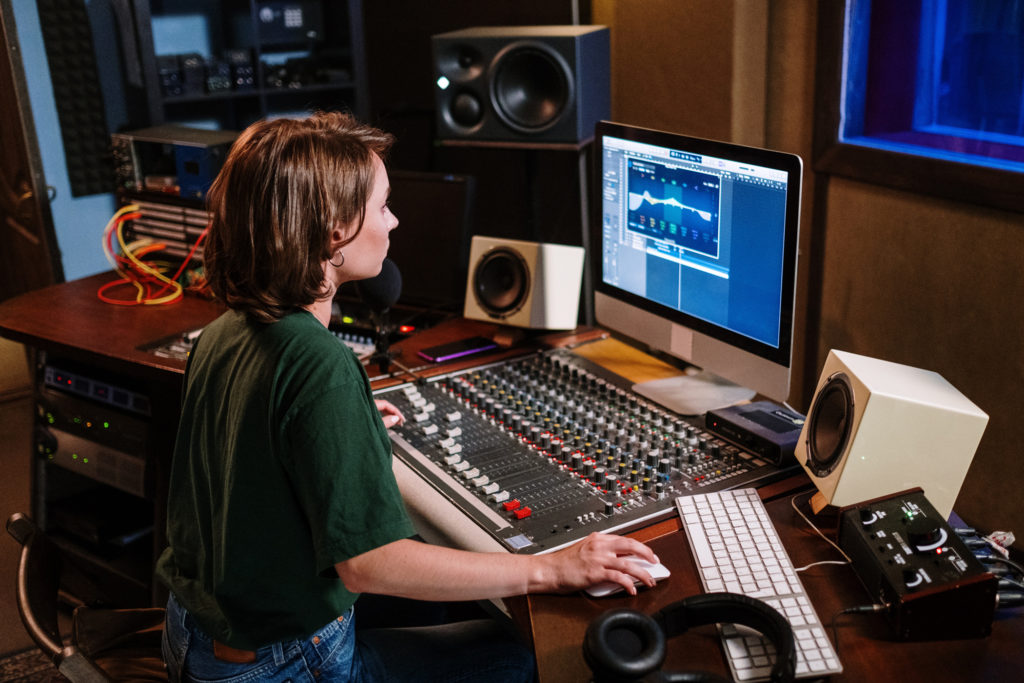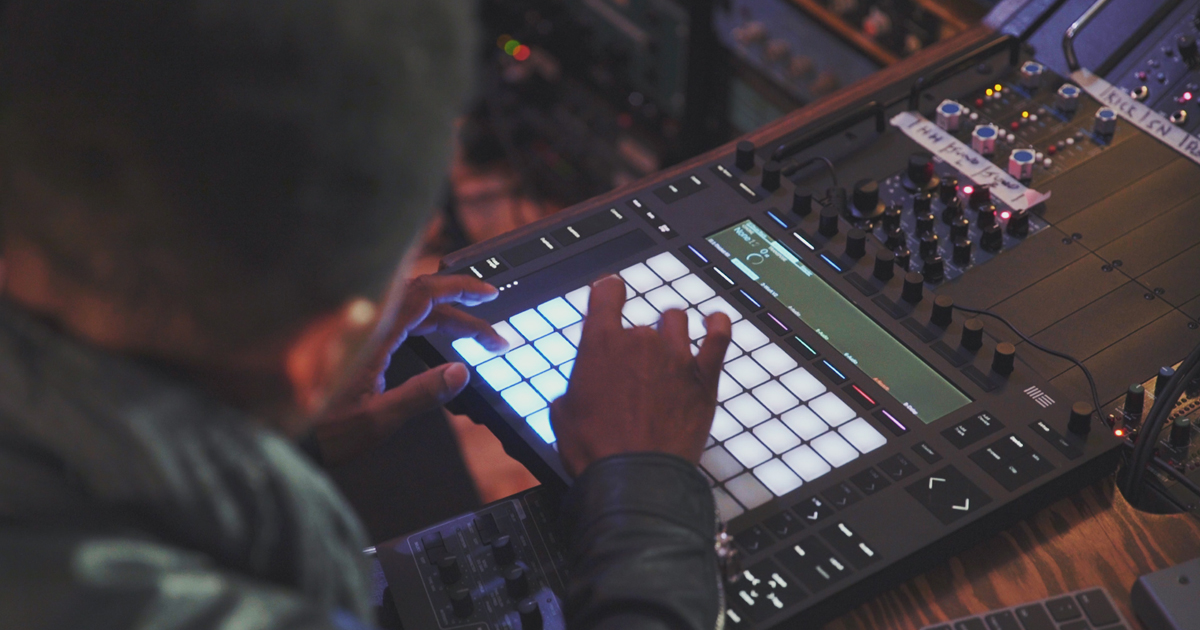+ Producers, Synth Heads and Sci-Fi Nerds, our new course with synthwave pioneer, Com Truise: Mid-Fi Synthwave Slow-Motion Funk, is out now!
By Brandon Miranda
If you’re new to mixing, or a sonic veteran, it’s no secret that today’s commercial music revolves around vocals. Engineers who can make singers sound great tend to secure the most work throughout the industry.
In fact, in my own current role as an engineer for APG/Atlantic, we solely focus on recording and mixing vocals.
With so much production being done in the box (another way of saying solely on computers), the need to record and mix instrumentals is not the same as it used to be. A crucial technique in this field is knowing how to get a great balance between lead and backing vocals.
Let’s take a dive into the tricks and secrets that some of the top engineers are using today.
1. Panning
It sounds like a no-brainer, but you would not believe how often I run into tracking/mixing engineers that don’t know they can pan out their vocals. The best practice is to create a “vocal sandwich” — have the lead vocal sit right in the middle of the mix with two or more backing vocals panned hard left and right. I usually record 2 doubles of a vocal (the exact same melody/lyrics) and 2 of each harmony, then pan those out left and right.
This effect provides two important results:
- It leaves space for the lead vocal to still retain the listener’s focus, and
- It makes the chorus of a song feel huge as every part of the stereo field is now covered by the vocal.
You can also get strategic with your panning and choose different pan points for each vocal part. Doing so will create a more spacious stereo image and can also add a three-dimensional feel to the vocal mix. For example, if you are a Pro Tools user, you can pan the doubled vocals all the way to 100 Left and Right, but then take the low harmonies into 35 Left and Right (and maybe the high harmonies to 75 L and R).
You can then adjust the volume levels of each part to prioritize how you want the backing vocals to feel. keeping the lower-panned vocals will make the mix feel warm and focused while emphasizing the vocals, and the hard left and right will make the vocal mix feel wide. This approach will allow clarity in the mix as each vocal part now gets its own special pocket to sit in the stereo field.
+ Read more on Flypaper: “Watch Kimbra Remix Her Vocals on “As You Are” (Video).”
2. Mid-side EQ/Compression
Mid-Side EQ and Mid-Side Compression are different paths to a similar outcome; they allow us to independently control the sonic balance between the middle and sides of the mix. In employing these techniques, an engineer can dramatically affect the width of a recording. When working with background vocals, I tend to compress the middle frequencies of the backing vocals and boost the sides.
This adds control to the middle of the mix so that the lead vocal does not have to compete. The result is a controlled but very spacious sound.
Try this, place all the backing vocals in one group, reach for a mid-side compressor (my favorites are the Elysia Alpha Master or the Waves PuigChild 670) and then add some heavy compression to the middle signals (5-7 dB of gain reduction). If your compressor has attack release parameters then I suggest having a fast attack with a moderate release. The objective is to control the peaks of the middle spectrum of the backing vocals so that they sit behind the lead vocal (that which is more dynamic will pop out to the front more).
Then, you can add some light compression (1-2 dB gain reduction) to the sides and even raise their output level. The end result will be a wide, yet controlled balance between the lead and backing vocals.
Also, if you are asking whether to use mid-side EQ or Compression, my answer is both will work. However, it all depends on your preferences for color. EQ will be cleaner and create more space, but using the compressor will be a little crunchier, adding warmth to the mix. I love the sound and attitude compression gets in a mix so I more often reach for that and only lean on EQ when there is a problem to clean up in the recording.
3. Sonic Contrast through EQ
Contrast is one of the most important principles one can understand as an engineer. Creating separation between elements becomes crucial when trying to squeeze a ton of auditory content down the tiny pipeline of an mp3. Always seek where you can create (and accentuate) opposites in your mixdown.
When working with vocals, I tend to add EQ to my background vocals that exaggerate the sonic differences from their lead counterparts. If I have a dark main vocal, then I’ll EQ the vocals to be bright and wispy. The opposite holds true if the lead vocal carries a lot of upper frequencies. This isn’t always the case, but a great technique to have in your palette in case you are struggling with keeping the vocals feeling separate. Keep it simple when you do this and add this main EQ to the whole group of the background vocal, instead of trying to painstakingly treat each vocal individually).
You will be surprised with how little EQ work the individual vocal tracks need to make the mix sound great.
+ Learn production, composition, songwriting, theory, arranging, mixing, and more; whenever you want and wherever you are. Subscribe for full access!
4. Glue Compression
I am ALL about processing backings at the group level. Not only does it save time, but logically the backing vocals should be all treated as one instrument (since that’s truly what they are: a choir). If I have issues (extra low-end or sibilant frequencies) then yes I will take care of those individually, but for the most part, I am working at gluing these elements together. Glue compression is a perfect technique for achieving this.
I like to have my backing vocals less dynamic than my lead. By squashing them more, relative to the main, I create a sense of control in the mix that allows the lead vocal to still retain its position at the front. I use a fast attack to tuck in the peaks and a moderate to slow release to retain the compression. This rounds off the transients of the backing vocals and allows this hierarchy to take place.
Now, keep in mind that this doesn’t have to be used in every mixdown; every now and then it’s actually great to allow the backing vocals to take precedence in a song. The dynamically loose vocals will grab the listener’s attention in an inspiring way (I recommend this approach for alternative music or Gospel-influenced records), but being aware of this technique will help you define when is a good versus bad time to employ!
5. Separating the Space Using Reverb
This last tip goes along with the principle of creating contrast in a mix. Reverb is a wonderful tool for adding three-dimensional space to a mix and helping to make elements feel like they are in their own pocket. Contrast is key, so I tend to follow the rule of opposites. Where a lead vocal is very wet with the verb, then I’ll usually contrast it with dry, upfront sounding backing vocals.
Another way to look at this is to think about the shock/awe factor you want to create once the backings enter. If you want the entrances to feel smoother and more subtle, then keeping all the vocals in a similar reverb will achieve this.
However, if you want the chorus to shock the listener once the backgrounds enter, then see what you can do to make the vocals sound opposite from one another.
One of my favorite plugins to play with on background vocals is Waves Audio’s CLA Vocals. It’s quick, dirty and has three different reverb tones (basically short, medium and long) that sound great on the background vocal group. Moreover, running all the backings through the same reverb will glue them together, again adding a new layer of transparency to the overall mix.
Don’t stop here!
Continue learning with hundreds of lessons on songwriting, mixing, recording and production, composing, beat making, and more on Soundfly, with artist-led courses by Kimbra, Com Truise, Jlin, Kiefer, and the new Ryan Lott: Designing Sample-Based Instruments.
—
Brandon Miranda is a Soundfly Mentor. Click here to work with him to achieve your next musical goal.





